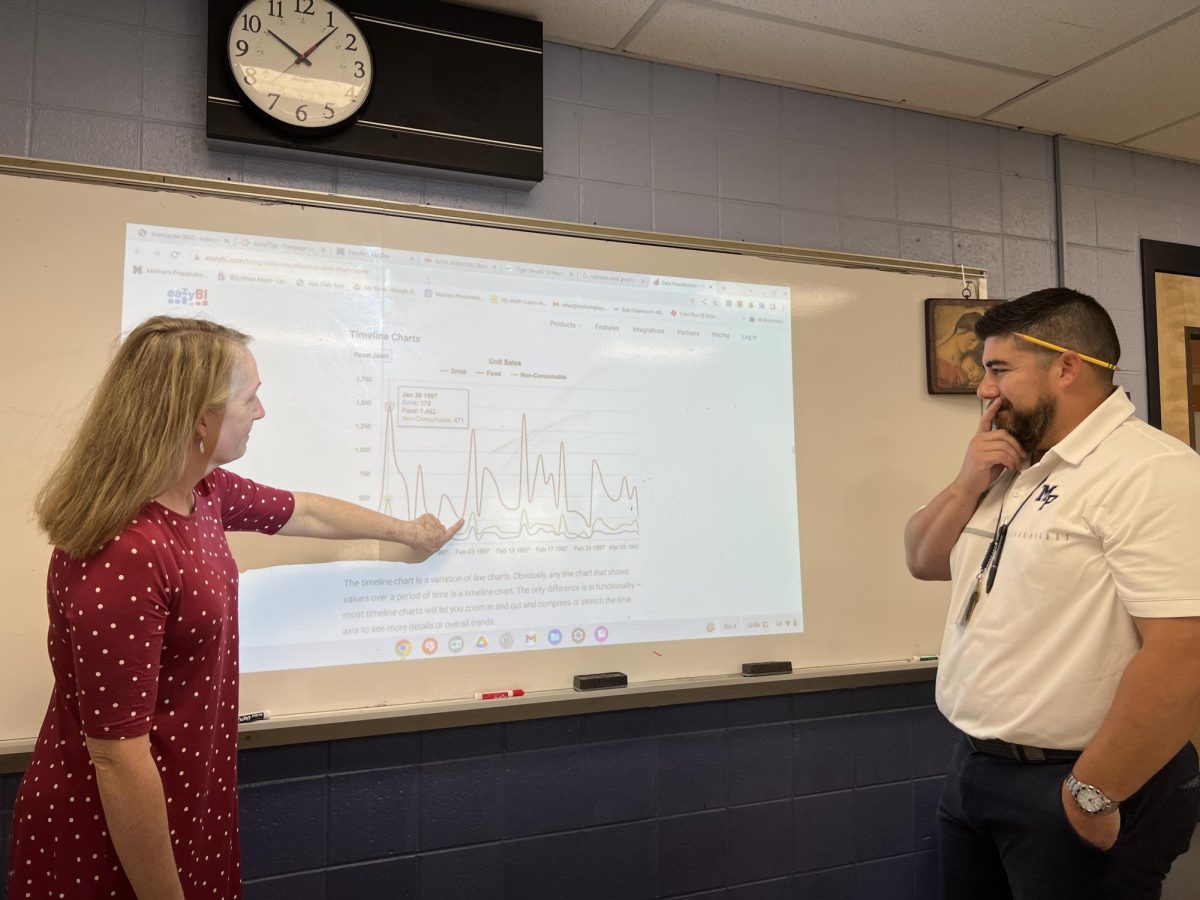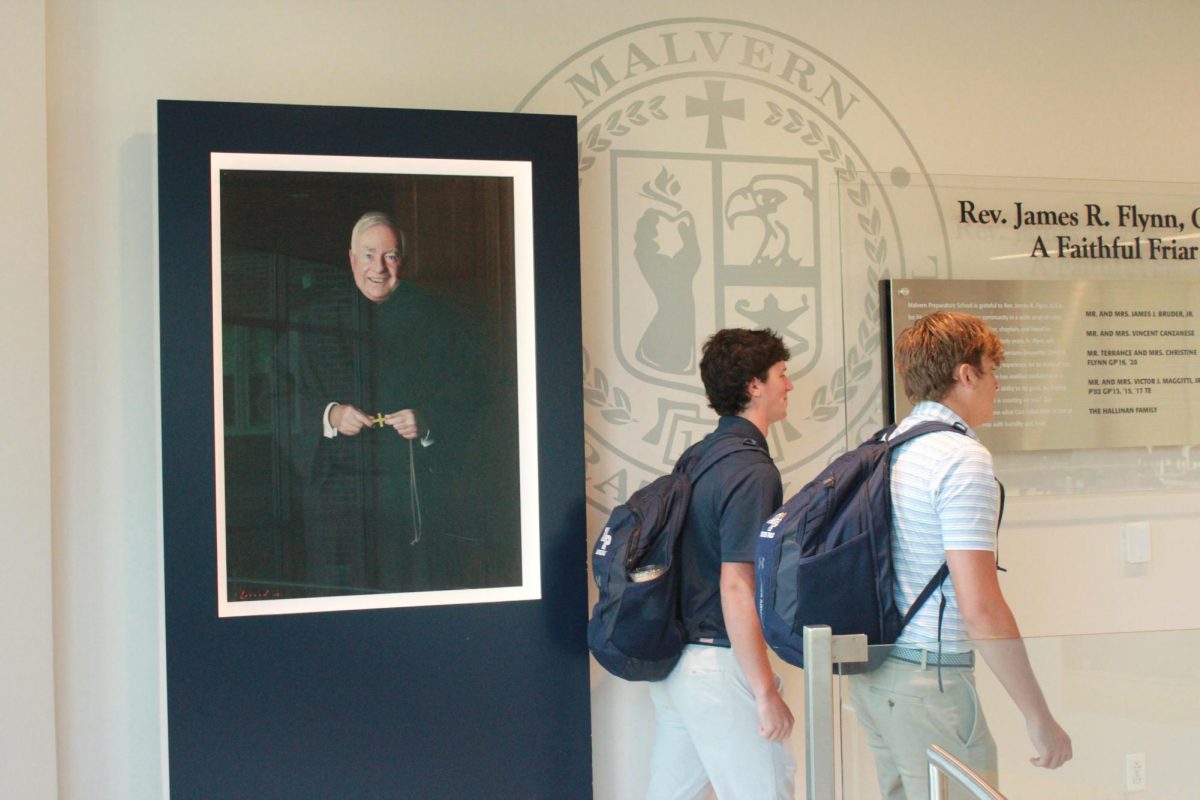Data analytics, the new math class on campus, has been immensely popular among the students. With applications to many professions, guest speakers, and project-based learning, the newest math course has a lot to offer to students. However, much planning and research were required to create the success we’re seeing today.
Mrs. AnnMarie Winfield, an AP Calculus AB, Statistics, and now Data Analytics teacher, remarks on the origins of the class and how inspiration sparked from sharing a classroom with Mr. Huf.
“Last year, Mr. Huf and I got to see a little bit of what each other does and realized that there was some crossover between our classes, especially between some of the extensions he was doing in applied Calc. When I was doing statistics, that lent itself to more data science, then it kind of blossomed from there,” Mrs. Winfield stated.
Mr. Myles Huf, an Applied Calculus and Data Analytics teacher, added to the origin of the class and collaboration with Mrs. Winfield.
“So part of what we love is the applied aspect of these courses, right? Like math is math, and I enjoy math at its core, but we love bringing the world to math. So we found that out about each other more in the classroom that same year. Mrs. Giordano entered a competition at St. Joe’s, a data analytics competition, and asked me if I wanted to help. I kind of dipped my toe in the water. I came to a couple of brainstorming sessions and found that I was really enjoying it. Having conversations around data. I joined the team at St. Joe’s in that first year. Then it kind of trickled into the following year—our conversations about having the class really amplified. So we entered the competition the next year and won. This told us that not only do we really enjoy talking about it, but we’re probably pretty good at talking about it,” Mr. Huf stated.
Another teacher, Mrs. Giordano, the math curriculum coordinator and an AP calculus AB and algebra 2 teacher, was integral in the development of the course.
“About three years ago, we realized here at Malvern that there was a need besides calculus for our boys. A lot of the guys are going into business, and while calculus is important, we really saw that there was a need for something more. So when we started thinking about a data analytics program, we first started at St. Joe’s Data and Analytics competition. Mr. Huf proudly boasted with his trophy last year, leading us to think, ‘This is going to be a great course.’ Between Mr. Huf’s experience in business and Mrs. Winfield’s experience in engineering and coding, the two of them could create this amazing course,” Mrs. Giordano stated.
Mr. Huf and Mrs. Winfield needed a framework to start. Luckily, through their research, they found that other high schools on the West Coast were moving towards the same goal.
“Although we loved it, we were not 100% sure we were ready to write our own curriculum. Our research discovered the UQ curriculum for high school Intro to Data Science that they have written. They started with a grant from the Gates Foundation to write one unit. And then, from there, they wrote an entire year’s worth of curriculum. It stems from the changes to the California high school math standards, where high schools in California public colleges recognize that not everyone needs the Pre-Calculus calculus track. So they are offering Intro to Data Science and Statistics as an alternate pathway to graduate high school and still meet your math requirements,” Mrs. Winfield remarked.
Through this research, they discovered that Stanford University employees were integral in developing data analytics courses on the West Coast. This was when Mr. Huf, Mrs. Winfield, and Mrs. Giordano decided to attend a conference at Stanford University.
“All the developed teachers are still working at Stanford, and they had an in-person week-long seminar to bring out people who were interested in teaching it, already teaching it, or have taught it to have a dialogue and brainstorm about how the course goes. We want to establish a framework, and the reason for that is that some subjects lend themselves very easily to a timeline. Think about history, start at the beginning, and go forward. Think about English, read a book. How do you do that with data, specifically in the math curriculum? There’s so much. Where do you even start? Do you start talking about sports? Do you start talking about social media? So we wanted this framework, and when we really started diving into it, I think it made a lot of sense how to use it,” Mr. Huf stated.
They gained information about how to teach the course and were exposed to its popularity outside of the West Coast.
“I was surprised that there were people from Australia, China, and Mexico at this conference. You know, in addition to people from and teachers from all over the country, and I was surprised that there were the three of us, and then there were two other people from Pennsylvania,” Mrs. Winfield remarked.
Mrs. Giordano also touched on the diversity among the conference’s guests.
“Every day, I had to sit with different groups of people. It’s a lot like Malvern, where it was very interactive. There were only two other people from Pennsylvania. I think there was a gentleman from China and somebody from Mexico. We met many people trying to do the same thing, helping our students figure out the best way to navigate data science. The whole thing was all-day learning. I think the biggest challenge for me was there was a lot of coding in it. So, I’m not a coder. It was good for me to see that and have to think about it before I can dig in. It was a great experience,” Mrs. Giordano stated.
During this Stanford trip, the framework for the data analytics course started to come together, and I saw what Malvern students could get out of the course.
“We want to enhance data literacy, which compounds into a more knowledgeable consumer. A more responsible consumer, what you’re consuming daily. That’s not just buying. You’re looking at your phone, you go to the store, the commercials on the TV. If you’re more knowledgeable about what’s happening behind the scenes, you are a more informed, more responsible consumer, so in the end, it suits that as well,” Mr. Huf said.
Mrs. Giordano also discussed how Malvern students could use the data analytics course instead of a Calculus track.
“We already have the stats course, which is very quantitative. Where data science brings in more computer programming, it’s more qualitative to tell the story. Some guys originally thought this could be good for guys who didn’t want to do the stats or the calculus but still needed to take math. But we’re finding that the people doing calculus and stats also do the data analytics. So it’s just another lens for them to use. It’s good for anybody to take because data analysis is booming. It’s going to be even bigger. Between now and, I think, 2031 will increase like crazy in all fields. So it’s a good thing to have, no matter what field you’re going into. It is a good skill. It will make them more marketable in the future,” Mrs. Giordano stated.
Mr. Huf also sees this class as giving Malvern students an advantage when transitioning to college-level courses.
“Picture yourself in college data analytics one on the first day. Nerves are always moving. You sit down and don’t know anyone in the class. The professor starts to write. 90% of the class had no course that even talked about 10% of what we discussed. Seeing a Malvern guy raise his hand on the first day and be 30 steps ahead of everyone else in the class excites me. We’re just not seeing it addressed the way we’re addressing it here. And going into college. I think that is a huge step up,” Mr. Huf stated.
Both teachers have high hopes for the class and its future. Ideas such as helping the Malvern staff with the collected data have arisen as potential plans for upcoming classes.
“We can get our students working with marketing for Malvern. Then marketing could use that. We’re job visits, getting the board involved, alumni associations, many possibilities,” Mr. Huf stated.
Data analytics started the year strong with its interactive material with real-world applications. Implementing new teaching strategies, earned honors, and inspiration from people worldwide are all a part of what makes this course so desirable. The future is bright for this new course, allowing Malvern students to pursue their interests in a new way.







